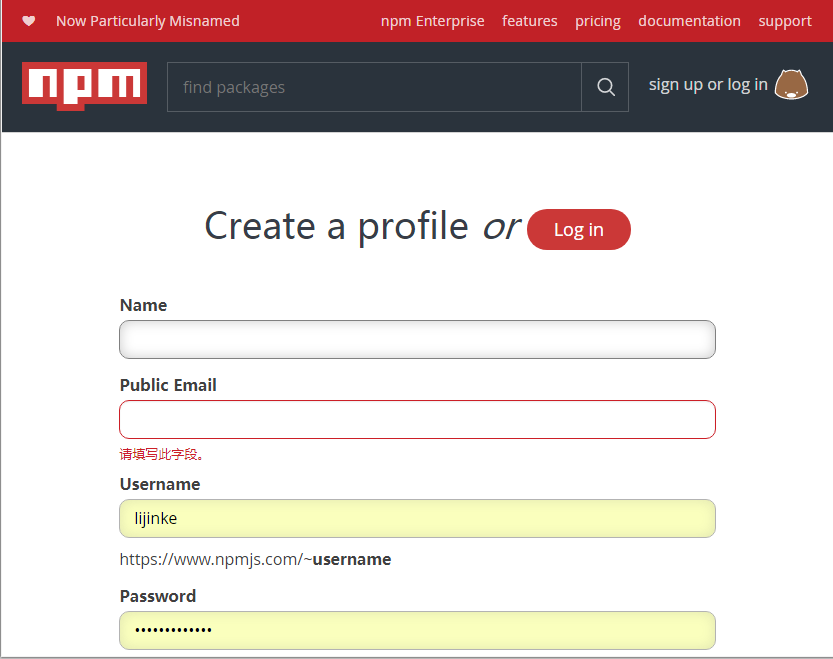1. 前言
作为一个前端,已经离不开 nodejs 相关的社区生态 , npm 提供的丰富的模块 更是方便好用,下面这个命令相信是最常用的
1 | npm install [module_name] |
那么别人的模块是怎么发布到 npm 供大家使用呢?这里分享一下我的小小的一点经验
2. 注册 npm 账号
访问 https://www.npmjs.com/signup 注册一个 npm 账号

这个不用多说,简单注册一下就可以了
3. 在命令行登录 npm
输入
1 | npm login |
之后输入 账号密码和邮箱

登录成功后 之后的包发布目的地 就是对应的这个地址
可以查看 某个模块的作者
1 | npm owner ls antd |
比如 antd, 可以看到 偏右大神 等等作者 ^_^
4. 前戏结束,开始正餐
我们这里先已一个 简单 的 webpack 插件 为例,有浅到深首先建立 项目结构

这是最基础的一个文件结构 ,
index.js为我们模块的入口LICENSE是 许可证 通常为MIT即可 不了解的可自行百度package.json最重要的一个 模块配置文件 关系到模块的发布相关细节README.md说明文档 可以介绍一下这个模块.gitignoregit 提交时 你想忽略的文件列表.npmignorenpm 模块发布时 你想忽略的文件列表 列表中的文件不会被发布到 npm 上面tests单元测试
4.1 编写主程序
编写 index.js
1 | const fs = require('fs'); |
代码具体细节不重要,这里简单的声明一个 function, 以 es5 的方式 编写,也不需要编译,原型链上挂载两个方法
apply 是 webpack 需要的一个 方法,可以拿到 打包时的上下文,transformFilePath 自定义的一个方法,可以在里面写一些你想实现的东西,最后导出这个 function
1 | module.exports = AddStaticCachePlugin |
那么使用者 下载模块时 怎么和 index.js 关联呢?这时候就要编写 package.json 了
4.2 编写 package.json
填写一些必要的信息
1 | { |
以上 就是一个 比较基本 的配置了
#1 入口文件
“main”:”index.js” 这里我们指定了 程序的主入口 是 index.js, 也就是当别人下载了这个模块
1 | npm i add-static-cache-webpack-plugin |
1 | const add = require('add-static-cache-webpack-plugin') |
此时就直接 require 的 index.js 可以根据实际情况指定 main 字段
#2 单元测试
开源模块,最好还是写一点单元测试,这样使其更加可靠
推荐使用 mocha + power-assert, 写法不用多说,大家都会
1 | describe('Test', function () { |
写好之后 npm run test 即可
#3 开发依赖
很多人都知道 npm i xx -D 和 npm i xx -S 会分别安装到 开发环境 和生成环境但如果不是发布模块 装到哪个地方问题其实不大
但是发布模块 就要仔细区分了,如果 模块代码 依赖了其他 第三方模块 就需要 -S, 也就是 dependencies 里面 这样别人下载模块时 会同时下载 这些第三方模块,而测试,调试,其他依赖 装在 devDependencies 里面 , 别人下载模块时 这些模块不会被下载,如果弄错了,会导致你的模块包很大
4.3 发布最后的准备
完善一些细节
完善 .gitignore 和 .npmignore
提交到 git 时 我们不希望出现这些东西
1 | node_modules |
提交到 .npmignore 时 我们不希望出现这些东西
1 | node_modules |
完善 开源协议
1 | MIT License |
完善 README.md
写一些如何使用 怎么安装,这些必要信息即可
5. 大功告成,发布
首先发布到 github 上
1 | git add . |
然后发布到 npm
1 | npm publish . |
稍等一会 模块发布成功,在 npm 官网查看
https://www.npmjs.com/package/add-static-cache-webpack-plugin
到此,差不多一个发布模块的流程就走完了,接下来就可以使用了
1 | npm i add-static-cache-webpack-plugin -S |
webpack.config.js
1 | const AddStaticCachePlugin = require('add-static-cache-webpack-plugin') |
完美
6. 结语
这只是一个最简单的模块,如果是 React,Es6 的组件模块的话,还要 babel 编译 js, postcss,j,less 编译 less,css, 单页测试也有一点不同,过于复杂,不便于初学,当然,以上也是我个人摸索出来的,肯定也不是很好
但其实我个人这种水平 制造的也只是 垃圾轮子而已 不会有太多人用,出于学习的目的当然还是有一定的好处,天天用别人的,不说写出那样的轮子,但是经过这么一摸索,至少知道了这种东西是怎么来的,也是极好的呀
